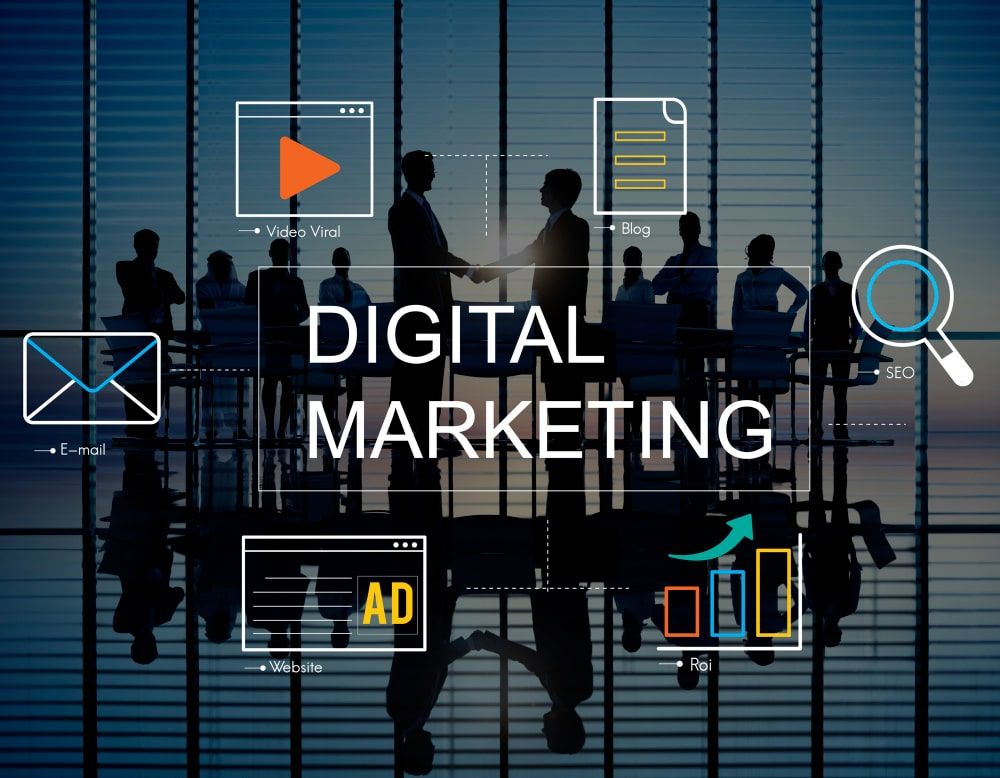Digital Marketing Strategy: effective and successful

Сontents
- What is a Digital Marketing Strategy?
- Strategy vs. Tactics: The Key Differences in Digital Marketing
- Components of a Digital Strategy
- Types of Online Marketing Strategy
- Guide: How to Build a Digital Marketing Strategy
- Examples of Effective Digital Marketing Strategy
- Secrets of a Successful Internet Marketing Strategy
If you are in any way interested in growing your business, having a well-thought-out digital marketing strategy is a must. There is just no way around it — you won’t get anywhere without promoting your brand on the Internet. But choosing between so many options might just make your head hurt — PPC, email, social media, SEO — what will provide the best results? In this article, we'll examine the best practices and offer practical solutions for creating a strategy that meets the needs of your business. Whether you are a small business or you work in a big company (maybe even own one), we will try to give you tips on how to enhance your online presence, interact with your target audience, and keep your competitive edge.
What is a Digital Marketing Strategy?
By definition, digital strategy is a comprehensive plan that consists of a coordinated series of actions, the goal of which is to help businesses achieve their online objectives. Creating a methodical approach that integrates all aspects of your online presence is far more crucial than concentrating on certain techniques like email advertising or SEO. Depending on how well your strategy is thought-out, it will either release you from half your duties as a business owner and solve most of your problems or it’ll give you even more of them and then some. So take this step very seriously and approach this topic with the greatest care.

Performance of your strategy, if successful, will one day become the face of your brand. Whether you’re aiming to increase brand awareness, drive traffic, generate leads, or boost sales, a well-formed online marketing strategy starts with defining clear, measurable goals.
Understanding your target audience serves as a foundation to any effective plan. There are a number of things you should know about the people you are selling to. Start from the basics: define their gender, location and age. Then, by using tools like Google Analytics and your own understanding of your product, dig deeper - what are their interests in life? How do you imagine them spending their free time? What jobs may they have? Create an image in your head and write it down. Understanding who your product is sold to on a deeper level will tremendously improve your chances of creating a marketing strategy that actually works.
The next step on your way to creating the best digital marketing strategy is to carefully select your channels. Your audience and goals will determine whether you focus on SEO to boost visibility, social media to attract a wider audience, or PPC ads to quickly target certain demographics. Every channel offers its unique approach and you need to understand how to properly use all of them. Think of it as a sort of a puzzle - your pieces should all fit together to create a perfect match. Depending on your product, target audience and goals, some pieces may be bigger than the others. This puzzle is a bit funny though - over time some parts may become smaller while others grow exponentially. It is to say - don’t forget to frequently review and optimize your plan!
Your road map to effectively navigating the digital market ultimately consists of a strong online strategy that includes customer data, clear objectives, and the ideal channel mix. With this agile approach your chances of achieving long-term success will greatly increase.
Strategy vs. Tactics: The Key Differences in Digital Marketing
The terms “strategy” and “tactics” are often interchanged and therefore often misused. Strategy is a cohesive, comprehensive plan you follow to reach your end-goals (don’t forget about our agile method here - sometimes plans don’t work and you need to not be afraid to make some changes). Where strategy is a plan, tactics are steps you take to make this plan actually work. Interestingly enough, building a strategy is easier for some people than to break it down into smaller steps.
In other words, strategies are the "what" and "why," whereas tactics are the "how." So this “puzzle” we talked about earlier on - tools like social media content creation, email marketing, targeted ad releases and SEO are all parts of it. Say, you want to increase your engagement rate - the tactics for it would be to host interactive Instagram Stories or provide live Q&A sessions on social media sites.
Strategy without tactics is as pointless as tactics without a strategy. Effective planning links the overarching vision with targeted, concentrated actions that complement each other to accomplish your business's goals. So it is a crucial skill to differentiate easily between strategy and tactics and utilize both of them equally and to their full potential.
Components of a Digital Strategy
Building a solid strategy requires a number of essential components and not one of them can be thrown out. Let’s study each of them in detail so we could gain a better understanding of what should be done in order to succeed.

Goals and Objectives
Every website marketing strategy starts with clear, well-defined goals. Try to stay away from common phrases like “increase sales” or “generate more leads”. Well, sure, but increase by how many percent? How many leads do you see yourself having after a specific time period? Make sure your goals have numbers in it that you can actually count and measure the success of your campaigns by. Specific, Measurable, Achievable, Relevant, and Time-bound objectives (SMART) work very well in this situation.
Audience Analysis
As stated before, a thorough grasp on your target market is a crucial step in any successful strategy. In addition to basic demographic information, this research looks at motives, interests, and behaviors. Find out who your product appeals to the most. Then take a closer look at the information you have gathered and start analyzing.
Let’s say your audience is 30-45 middle-class women, mostly from the countries of Europe. That's not enough to sell a product. Do they spend their free time mostly at home or going out? What kind of content do they consume? How much time do they spend online? Do they have a family, kids? Ask yourself these questions and more. Using this technique you will paint a comprehensive portrait of your average buyer therefore getting closer to your goals.
Competitor Analysis
A good strategy examines both the inside and the outside. Unless you try to sell some innovative product that is conceptually a completely new thing that has never been done before (if so, go patent it before anything else), there are a number of people who've done digital marketing before you. Don’t shy away from analyzing what they have been good at and where they seemed to fail. Knowing your competitors is a step that cannot be undermined. Analyze other companies’ successful and failed campaigns to make a better one.
Value Proposition and Unique Selling Points (USPs)
Continuing our previous point, you need to know and be able to explain why your product is either unique or just better than the ones of your competitors. The market right now is overflowed with a huge amount of different products and services made for every purpose imaginable. Your unique selling points (USPs) is what makes you stand out among thousands of sellers, so make sure you have good ones. USPs provide clients with a reason to interact with and trust your business, regardless of whether they represent specialization, outstanding service, or unique goods.
Content Strategy
After doing your research you now should plan every piece of content you create. Your posts on social media and ads serve as a face of your brand, so make sure to give your potential clients a good first impression. Through social media you also may create a stronger relationship with your audience, which allows you to make a great selling point.
In our day and age authenticity is the biggest factor of them all when talking about what you choose to post. So depending on your USPs, again, choose accordingly a way to communicate with your audience.
Types of Online Marketing Strategy
Previously we mentioned several types of online marketing. To build our strategy-puzzle it is highly important to understand at least in some detail how every type of these digital marketing tactics work.
SEO (Search Engine Optimization)
If you ever looked something up on Google (if you haven’t, we are deeply impressed), you probably rarely, if ever, went further than the results you get on the first page. To get to the first page, some work must be done. Simply put, that’s what SEO does. SEO specialists optimize your website to certain search queries so the users may find it among countless number of pages. If you want people to be able to find your products or services through websites, definitely consider this marketing tool.
PPC Advertising (Pay-Per-Click)
While very effective, SEO takes some time for you to actually see the results. If you’re looking for a faster way to encourage your target audience to engage with your website, try PPC advertisements. With platforms like Google Ads, you can select particular keywords, establish your spending limit, and only pay when a user clicks. PPC is perfect for targeting particular groups because of its versatility, which, with proper management, may increase conversions.
Social Platform Engagement
All of us probably have some form of social media - it’s unavoidable at this point. Creating content that provides an understanding of your business is a focal point in our day and age. Having engaging content allows you to gain a loyal audience that at some point will do marketing instead of you. Never underestimate the power of social media and how it affects people, especially if your target demographic is below 35 years of age. Other than that, your social media works in tandem with other forms of marketing providing recognition for your brand and increasing exposure all together.
Influencer Partnerships
We cannot talk about increasing exposure online without talking about partnering with influencers. Hot take: influencer marketing might easily be the most effective way to gain more leads and make your brand known to a wider range of users. Influencer marketing started back in the 2000s, when YouTube came into play. The reason why it works so well is that the said influencers already have a following base that trusts them. More than that, you get to choose influencers based on their target audience that aligns with yours, which gives you a platform of people who are already potentially interested in buying what you’re selling.
Email Campaigns
Emailing is, to this day, still a very relevant tool. Newsletters, exclusive deals, and re-engagement initiatives are a few examples of communications that may be done through emails. It helps you keep in touch with your current customers by notifying them on sales, special offers or new products. Advanced automation also makes timed delivery possible, guaranteeing that messages are sent to clients at the appropriate time.
Educational Content
Offering educational materials gives you authority and shows your expertise on the topic. By doing so you will gain trust from the internet users therefore making your brand more respected. White papers, movies, webinars, blogs, and other types of content are all included in this. High quality articles with usage of keywords may also work in your favor by drawing in organic visitors to your website. This is again a great tool to use to increase your online presence.
Guide: How to Build a Digital Marketing Strategy
As we have talked about everything in detail, let’s sum it up and make a compelling guide on how to build your perfect digital marketing strategy.

By now we understand that creating a successful digital marketing strategy is a step by step process that requires the use of many different tools and a thorough analysis. It might seem extremely overwhelming so let's break this process down one more time.
- Step One: Set Your Goals.
The numbers are your friends here. Establish your goals in a way you can measure. Follow the SMART principle - Specific, Measurable, Achievable, Relevant, and Time-bound objectives.
- Step Two: Analyze Your Audience.
Create a cohesive profile of your perfect customer. Imagine their age, gender, where they live, try to think of how they would spend their normal day. Use tools such as Google Analytics and other metrics specific to different platforms to gain knowledge on everything you possibly can (within the law of course). Having a deeper understanding of your potential clients helps you make unique marketing points.
- Step Three: Analyze Your Competitors
Use the information given - see how sellers who work in the same field as you build their digital marketing. What worked for them and what most certainly didn’t. Here’s a tip for you: as well as looking up to your prosperous rivals, try to look for the competitors who weren't successful in their marketing. You can learn from their mistakes to avoid making the same.
- Step Four: Define Your USPs.
Your Unique Selling Points is what makes you stand out among hundreds of businesses alike. So take your time and approach this task with great care. This is your main marketing point, this is why people should buy from you. Build your campaigns around it.
- Step Five: Content Strategy.
Make your online presence authentic to you and your business. Carefully think about your content plan and how you want to be perceived by the public. In our time it defines the brand as a whole.
- Step Six: Choose Desired Types Of Online Marketing.
Congratulations! You’ve done a fantastic job on this huge difficult task. Now based on what you’ve learned from your analysis, you can finally build your strategy puzzle and select types of marketing that fit you and your business specifically.
Examples of Effective Digital Marketing Strategy
Colin Kaepernick led Nike's "Dream Crazy" campaign, which is among the greatest examples of an online campaign that resulted in notable growth. Nike engaged customers with captivating stories and took a strong stand on social issues in addition to selling products. This attempt aimed to reach their major target demographic, which is mostly Gen Z and millennials who value authenticity and social responsibility.

Here’s how Nike structured this campaign into an effective digital marketing strategy:
When Nike first began out, its mission was very clear: to solidify its standing as a bold and forward-thinking business. Nike focused on creating messages that would really connect and inspire customers after recognizing that their audience appreciates businesses that have a social conscience. Increasing customer loyalty and attracting new customers who share similar values was the clear goal.
Nike employed a variety of platforms to boost reach and effect. The campaign included engaging video ads, social media content, influencer partnerships, and paid advertising. They connected with people on the channels where they were most active, spreading the word on social media platforms like YouTube, Instagram, and Twitter to ensure broad exposure.
With its compelling message to "Believe in something, even if it means sacrificing everything," this campaign was more than just a commercial. This memorable tagline and an interesting movie not only reaffirmed Nike's principles but also sparked conversations that extended well beyond the company's product promotion.
Key performance indicators (KPIs) such brand mentions, shares, and engagement rates were used by Nike to gauge the campaign's success. By employing a data-driven approach, they were able to monitor and enhance engagement in real-time, increasing visibility and effectiveness. Millions of social media interactions, more loyalty, and a significant rise in online sales were among the impressive results that strengthened Nike's position in the market.Key performance indicators (KPIs) such brand mentions, shares, and engagement rates were used by Nike to gauge the campaign's success. By employing a data-driven approach, they were able to monitor and enhance engagement in real-time, increasing visibility and effectiveness. Millions of social media interactions, more loyalty, and a significant rise in online sales were among the impressive results that strengthened Nike's position in the market.
Secrets of a Successful Internet Marketing Strategy
The secret to crafting an internet marketing strategy that consistently drives results is to follow the steps we described with precision yet to still remain flexible with the whole process. If you were to gather two things from this entire article: agility and constant analyzing means everything in marketing.
It is so easy to follow the path that’s already been paved, and, to be honest, in some way you should. Many professionals carefully crafted the act of selling for you to learn from it and take what you need. Yet we are all unique and in the sea of businesses you should always stay true to yourself.
Use tools that are given to you, but always remember to add your own twist to you. Find out how things work, but also bring something new to the table. That’s how successful brands and campaigns are made: try to think of those campaigns that really worked on you. They usually rely on basic selling principles but always catch your attention with something unique or very specific to the brand.
Marketing, in a way, is a form of art. And in any art form there are rules that people learn, the basics. But what truly makes a great artist is learning these rules, learning how to utilize the tools and on top of that creating something brand new that really stands out. Be open to new ideas even if they don’t align with what you usually would do.
So to sum it up, in our opinion the secret to successful marketing is: to analyze, to adapt and to create.
31.10.2024
107 article view
Similar articles
29.08.2025
Multi-Platform Influencer Strategies: Maximizing Reach Across All Channels
The digital marketing landscape has transformed dramatically, with influencer marketing emerging as a...
30.05.2025
How to Create An AI Influencer For Free for Instagram
The industry is evolving rapidly, shaped by the growing influence of AI technology. Among the most compelling...
18.04.2025
How to Start Your Own Influencer Marketing Agency
Launching an influencer marketing agency means entering one of the fastest-growing sectors in digital...